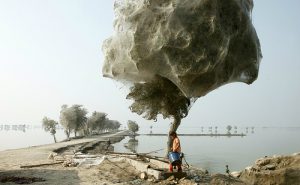To me, Darwin stands above all for our connectedness with other species: for human as part of nature. But the current cultural climate in China, where human “development” is happening at nature’s expense, stresses a cut-off between human and animal. Most people I met there, except zoologists, regarded animals as a human right to use, enjoy, master, consume.
Behind our attitudes to Darwin lay utterly different cultural legacies. Theirs were shaped partly by the fact that historically nature did pose terrible threats. The Yellow River, cradle of Chinese civilization, was also “China’s Sorrow”, the great flooder, taker of lives. Dam-builders were heroes.
Today China’s rivers, above all the Yangtze, are sorrow in a different sense: drying up, polluted, losing fauna, threatening the environment by what humans have done to them. A third of the Yellow River is unusable for agriculture or industry because of factory discharges and city sewage. New dams have destroyed a lot of the nature on which human well-being depends.
You might compare understanding a part of nature, like another species, to understanding another language. You learn the animal’s biology, behavioural characteristics and ecology as you learn the grammar, syntax and vocabulary of a language.
But you never learn another language in a vacuum. You have to do it relationally, and learn foreign words through realising how they correspond to and translate your own.
And to understand another animal species you need to take in the ways your particular culture has conditioned you to see it. You need to know an animal not only in relation to where it lives (its prey, who preys on it, its habitat, its place in the eco-system) but also in relation to who is trying to understand – who you are, where you and your ways of understanding come from, how your ways of seeing were formed. In other words, its relation to human culture.
Human beings are relentlessly symbolic. We make sense of what’s outside us in terms of what it means to us inside, and the ways different cultures symbolise an animal may now, in this age of mass extinctions, help determine whether that species survives.
In Tigers in Red Weather, I wanted to set tigers in the symbolic web of each country’s art, religion and history. From Laos to Bangladesh, Korea to Sumatra, the tiger has had a very different symbolic heft. It has a better chance of survival in Bhutan, where it is represented as one of the protectors of Buddhism, than China, where sexy ferocity (and the illusory possibility of acquiring some of that, magically, by ingesting its body parts) is part of the way that culture symbolises the species.
The Cult of the Tiger and Exotic Aliens
Valmik Thapar
In The Cult of the Tiger, Thapar discusses the many cults and representation of the tiger across Asia. He argues, sadly, that as the hold of these cults diminishes in each country, the animal itself is more at risk – from poachers, as well as loss of habitat.
More recently, in Exotic Aliens: The Lion and the Cheetah in India, he explores the symbolism of the lion from the ancient Middle East, Phoenicia, Babylon, Assyria and Palestine down to modern India. Through a labyrinth of art history, he documents the way the Mughals imported wild animals from Africa for royal menageries and hunting parks and argues radically that neither lions nor cheetahs were originally indigenous to the Indian subcontinent. He also shows how humans exploit animal symbols to enforce their own status in other people’s eyes: to symbolise themselves to themselves.
The Last Panda
George Schaller
In 1988, the zoologist George Schaller travelled with his wife to a remote region of China to study giant pandas, said to be shrinking in number because bamboo was declining. The real reason, he found, was that they were being caught and sold to zoos where they often died. Since then, wild pandas have increased; so has Chinese understanding of the need to maintain wildlife in its habitat.
The book is an evocative account of wild animals in their wild habitat observed by a great scientist passionate about his work. While there, he handed out cards to wildlife hunters that read: “All beings tremble at punishment. To all, life is dear. Comparing others to oneself, one should neither kill nor cause to kill.”
But it is also a parable of one animal’s fate in human culture. In “rent-a-panda” deals, China hires out these slow, fragile, endangered creatures for huge sums of money across the globe. The book moves poignantly from grainy portraits of these extraordinary animals in their damp bamboo forest to the frontline of their contact with humanity and on to their unenviable role as commercial pawns in international politics.
A Forest Journey: The Story of Wood and Civilization
John Perlin
From the beginnings of human culture, wood was humanity’s main fuel and building material. It still is, in many parts of the world. Perlin describes how from ancient Mesopotamia on, cultures flourished and rose as they used the forests and declined as they used them up. Ancient Gilgamesh fights the “forest demon” and fells irreplaceable cedar forests, which eventually leaves the land a desert. From the “door tax” imposed in ancient Babylon, as wood became scarcer, to the pivotal role forests played in the struggle between England and its colony America, the book is a heartrending object lesson in the way human culture both depends on and destroys nature.
The Running Sky
Tim Dee
Full of the precise observation which both a poet and a naturalist require, this is about what birds can mean to human beings; about poetry and growing up; about the love and need for birdwatching as parallel to the love and need for poetry. Its own beautiful language – a redstart is a “delicious blur of rust” – illustrates the way the habit of attention, both to the natural world and to words, can translate nature utterly movingly and generously into culture.





